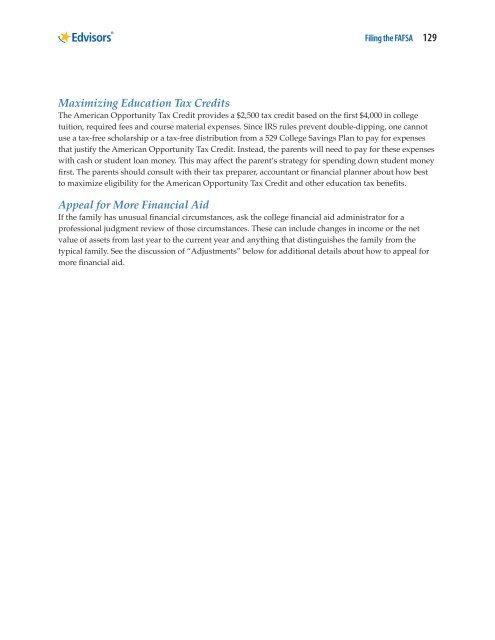filing-the-fafsa-2015-2016-edition
filing-the-fafsa-2015-2016-edition
filing-the-fafsa-2015-2016-edition
You also want an ePaper? Increase the reach of your titles
YUMPU automatically turns print PDFs into web optimized ePapers that Google loves.
Filing <strong>the</strong> FAFSA 129<br />
Maximizing Education Tax Credits<br />
The American Opportunity Tax Credit provides a $2,500 tax credit based on <strong>the</strong> first $4,000 in college<br />
tuition, required fees and course material expenses. Since IRS rules prevent double-dipping, one cannot<br />
use a tax-free scholarship or a tax-free distribution from a 529 College Savings Plan to pay for expenses<br />
that justify <strong>the</strong> American Opportunity Tax Credit. Instead, <strong>the</strong> parents will need to pay for <strong>the</strong>se expenses<br />
with cash or student loan money. This may affect <strong>the</strong> parent’s strategy for spending down student money<br />
first. The parents should consult with <strong>the</strong>ir tax preparer, accountant or financial planner about how best<br />
to maximize eligibility for <strong>the</strong> American Opportunity Tax Credit and o<strong>the</strong>r education tax benefits.<br />
Appeal for More Financial Aid<br />
If <strong>the</strong> family has unusual financial circumstances, ask <strong>the</strong> college financial aid administrator for a<br />
professional judgment review of those circumstances. These can include changes in income or <strong>the</strong> net<br />
value of assets from last year to <strong>the</strong> current year and anything that distinguishes <strong>the</strong> family from <strong>the</strong><br />
typical family. See <strong>the</strong> discussion of “Adjustments” below for additional details about how to appeal for<br />
more financial aid.


